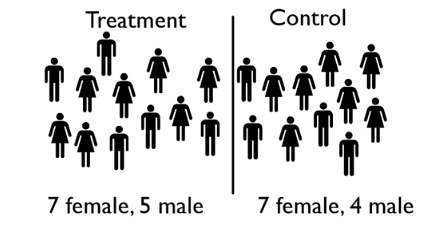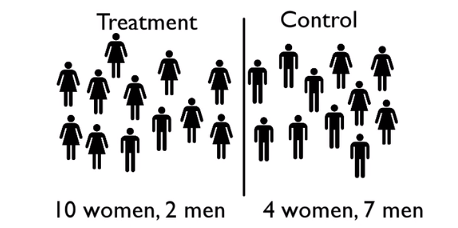Table of Contents |
A completely randomized design means that treatments will be randomly assigned to individual participants in an experiment.
An advantage of this design is that it is very quick and easy to implement. You could take your group of experimental units, assign them a number, and have the odds in the treatment group and the evens in the control group. Alternatively, you could roll a die for each subject, putting ones and twos in the control group, threes and fours in the first treatment group, and fives and sixes in the second treatment group.
However, a disadvantage of this design is that treatment and control groups could have disproportionate representations of the population.
IN CONTEXT
Let’s say you developed a new drug to combat the symptoms of acid reflux. You want to see if it’s more effective than what is currently available. You get 500 volunteers and write “1” on 250 slips of papers and “2” on the other 250 slips of paper. You put all 500 sheets of papers into a hat, mix them up, and the volunteers retrieve one slip of paper each.
Those who selected “1” will receive the new drug, and those who selected “2” receive the drug that's currently available. This is the simplest way to assign subjects to treatments. However, it's not necessarily ideal for every scenario.
Let’s say that the acid reflux drug is more effective for men than it is for women. It’s not really a problem if you divide the treatment control groups like this:

In this particular case, you can see there is roughly the same number of females and males in the treatment group and the control group. Since there is a relatively equal assignment on each side, it will be easy to see if the new drug is more effective for males than for females. Problems occur when the random assignment doesn't match the proportions of the population equally.
Consider for a moment if this happened:

Both groups are roughly the same size. Will you be able to determine if the treatment is more effective for men? Why not?
If the drug were more effective for men than women, you actually wouldn't notice because there aren't that many men in the treatment group. The proportions are way out of whack. This sometimes happens with random assignment.
You can see that in a completely randomized design, subjects are assigned using random processes such as numbers in a random number generator, random number table, numbers in a hat, or names in a hat. The problem is that it's not always the best way to assign treatments.
Source: THIS TUTORIAL WAS AUTHORED BY JONATHAN OSTERS FOR SOPHIA LEARNING. PLEASE SEE OUR TERMS OF USE.